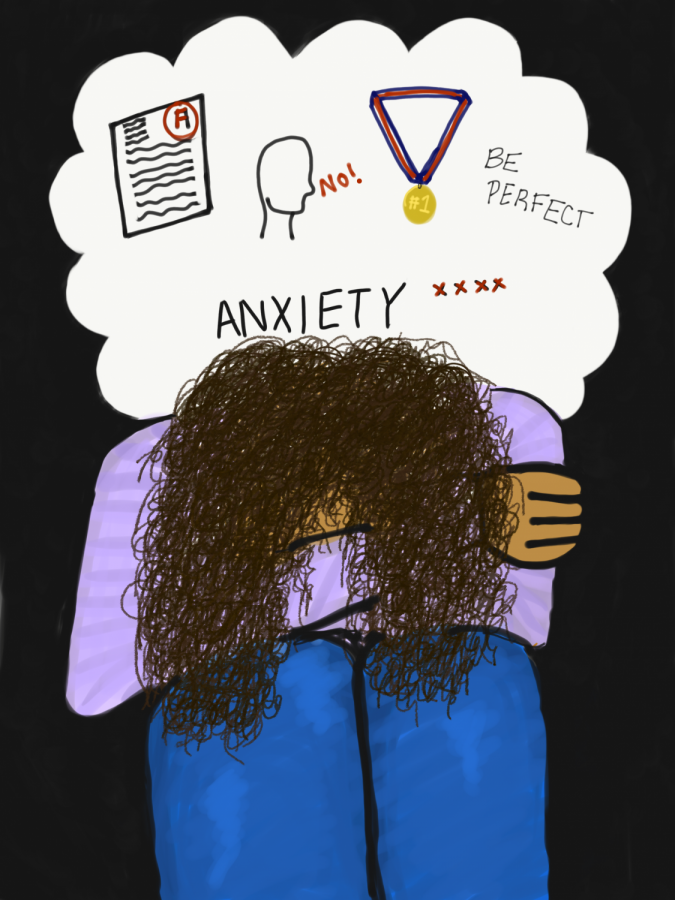More than “stressed”: anxiety, school and social media
August 21, 2019
As summer ends, many students may find themselves dreading the anxiety that school causes. It’s normal for high schoolers to be affected by stress, but for students with anxiety, the feelings are more than just a momentary panic.
I was diagnosed with an anxiety disorder in seventh grade, and I still notice symptoms of my mental illness: sweaty palms, increased heart rate, inability to concentrate, and a rapidly wandering mind that is quick to jump to conclusions.
According to the Anxiety and Depression Association of America, 31.9 percent of teenagers in America have also been diagnosed with some type of anxiety disorder. Of those teens, 80 percent of them do not receive any professional mental health treatment [talk therapy, exposure therapy, or access to medication].
But this may not be the reality for some students at ETHS. ETHS employs one school psychologist per grade level, as well as a large team of social workers and counselors.
“We’re very lucky here,” says Katherine DeWeese, the psychologist for the class of 2021. “That was something that they had to fight for for a while… saying ‘We need more mental health support.’”
According to the ETHS website, school psychologists “improve academic achievement by conducting and interpreting psychological, academic, and social emotional assessments, while promoting the use of data driven decision.”
One of the main tasks for a psychologist at ETHS is testing students for mental illness. School psychologists also facilitate counseling sessions, attend AM support and Wildkit Academy, communicate with teachers, and educate parents about mental health.
“There’s a lot of support that people don’t utilize all the time,” says DeWeese.
Psychologists aren’t the only ones who support the mental health of ETHS students. Luella Gesky, a P.E. and Health teacher, points her classes in the right direction when it comes to mental health.
“One of the intents [of the spring health unit] is to help people identify and self-identify, and be able to access the resources within the building and in the community,” she says.
The spring health unit Gesky refers to is a course dedicated to educating freshmen about “the most common ailments [P.E. teachers] see in freshmen: anxiety and depression,” Gesky says.
Like many adults I’ve talked to in my life, both DeWeese and Gesky predominantly blame social media for anxiety.
“I just feel we’re dealing with a completely different world right now, and teenagers are having to deal with things that none of us had to deal with,” DeWeese says.
Gesky echoes DeWeese’s opinion.
“I think our social media culture has created a toxic environment for students,” says Gesky.
Senior Laurel O’hare has other ideas. O’hare deals with her clinical anxiety every day and believes adults are too quick to place the blame on technology rather than stressors like school and extracurricular activities. She logs out of Snapchat and Instagram occasionally, but says that it doesn’t improve her mental health.
O’hare identifies school as her dominant stressor, saying that the “environment of high school puts a lot of pressure on both friend groups and academics.”
Senior Ananya Visweswaran describes herself as having a “severe fear of failure.” She believes her stress comes mainly from school and college applications. Social media, she says, can actually help her feel better and separate herself from her worries.
“Adults, from my experience, tend not to understand how social media can exist as a tool to find resources… it may not be super healthy as it prevents me from directly confronting my stress and its sources, but I have found it to be very useful at times,” Visweswaran says.
While schools like ETHS have not been able to systematically address student’s anxiety, professionals like DeWeese have ideas around what would soothe anxiety among some students.
“If I had a magic wand, the first thing I would think of was having a time in the day that everyone has free, to either just chill or get extra help without missing class,” DeWeese says.









jacob • Feb 13, 2020 at 9:17 pm
I have 14 year old daughter ,OHH lord never knew in this age they give too much time for the foolish social media .the homework load is so high for high schoolers and last minute panic attack is so crazy .Our home atmosphere is so stressful and chaotic revolves around teenage tantrums .I was a high schooler but never knew this kind of stress in my life.